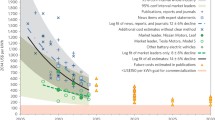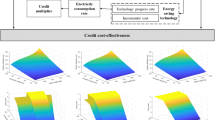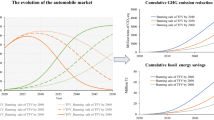Abstract
Hundreds of gigawatt-hours of lithium-ion batteries are being produced and installed on electric vehicles globally every year, causing considerable environmental and resources consequences. Understanding the driving factors behind battery installation is critical to propose co** strategies. In this study, we analyze China's electric passenger vehicles as an example. We decompose annual battery installation into vehicle sales, electric range, and energy consumption rate. We then investigate their impact on battery installation using a logarithmic mean Divisia index approach. The results show that vehicle sales were the dominating influencing factor, responsible for over 60% of yearly battery installation increase in most years since 2015. Vehicle electric range has largely evolved to be longer, imposing a positive influence on battery installation. Energy consumption rate was the only factor that has inhibited battery installation, but far from offsetting the impacts from the other two factors. The analysis suggests that to suppress over-growth of battery installation in the decades to come, managing electric range could serve as the major co** measure. In particular, stronger policy efforts should be targeted at limiting the electric range of large vehicles.
Graphical abstract









Similar content being viewed by others
Data availability
All data generated or analyzed during this study are included in this published article.
References
CPCA (2023) National passenger car market analysis in March 2023. China Passenger Car Association. http://www.cpcaauto.com/
China-SAE (2021) Energy conservation and new energy vehicles technology Roadmap 2.0. China Machine Press. China Soc Automot Eng.
Ciez R, Whitacre J (2019) Examining different recycling processes for lithium-ion batteries. Nat Sustain 2:148. https://doi.org/10.1038/s41893-019-0222-5
Chong CH, Tan WX, Ting ZJ, Liu P, Ma L, Li Z, Ni W (2019) The driving factors of energy-related CO2 emission growth in Malaysia: the LMDI decomposition method based on energy allocation analysis. Renew Sustain Energy Rev 115:109356. https://doi.org/10.1016/j.rser.2019.109356
EVCIPA (2023) Operation status of national electric vehicle charging and swap** infrastructure in July 2023. China Electric Vehicle Charging Infrastructure Promotion Alliance. http://www.evcipa.org.cn/
Goh T, Ang BW (2018) Tracking economy-wide energy efficiency using LMDI: approach and practices. Energ Effi 12(4):829–847. https://doi.org/10.1007/s12053-018-9683-z
Hasan MM, Liu K (2022) Decomposition analysis of natural gas consumption in Bangladesh using an LMDI approach. Energ Strat Rev 40:100724. https://doi.org/10.1016/j.esr.2021.100724
Hao H, Geng Y, Tate JE, Liu F, Chen K, Sun X, Liu Z, Zhao F (2019a) Impact of transport electrification on critical metal sustainability with a focus on the heavy-duty segment. Nat Commun 10(1):5398. https://doi.org/10.1038/s41467-019-13400-1
Hao H, Geng Y, Tate JE, Liu F, Sun X, Mu Z, Xun D, Liu Z, Zhao F (2019b) Securing platinum-group metals for transport low-carbon transition. One Earth 1(1):117–125. https://doi.org/10.1016/j.oneear.2019.08.012
Hao H, Ou X, Du J, Wang H, Ouyang M (2014) China’s electric vehicle subsidy scheme: rationale and impacts. Energy Policy 73:722–732. https://doi.org/10.1016/j.enpol.2014.05.022
He Y, **ng Y, Zeng X, Ji Y, Hou H, Zhang Y, Zhu Z (2022) Factors influencing carbon emissions from China’s electricity industry: Analysis using the combination of LMDI and K-means clustering. Environ Impact Assess Rev 93:106724. https://doi.org/10.1016/j.eiar.2021.106724
IEA (2022) Global EV Outlook 2022. International Energy Agency. https://www.iea.org/reports/global-ev-outlook-2022
Kempton W (2016) Electric vehicles: driving range. Nat Energy 1(9):16131. https://doi.org/10.1038/nenergy.2016.131
Kolesnikova A (2022) State of charge: EVs, batteries and battery materials (2021 H2). Adams Intelligence. https://www.adamasintel.com/report/download-state-of-charge-evs-batteries-and-battery-materials-2022-h2/
Li R, Han X, Wang Q (2023) Do technical differences lead to a widening gap in China’s regional carbon emissions efficiency? Evidence from a combination of LMDI and PDA approach. Renew Sustain Energy Rev 182:113361. https://doi.org/10.1016/j.rser.2023.113361
Rezvani Z, Jansson J, Bodin J (2015) Advances in consumer electric vehicle adoption research: A review and research agenda. Transp Res Part D Transp Environ 34:122–136. https://doi.org/10.1016/j.trd.2014.10.010
Sun X, Liu G, Hao H, Liu Z, Zhao F (2022) Modeling potential impact of COVID-19 pandemic on global electric vehicle supply chain. iScience 25(3):103903. https://doi.org/10.1016/j.isci.2022.103903
Wang X, Yan L (2022) Driving factors and decoupling analysis of fossil fuel related-carbon dioxide emissions in China. Fuel 314:122869. https://doi.org/10.1016/j.fuel.2021.122869
Wang H, Ang BW, Su B (2017) Assessing drivers of economy-wide energy use and emissions: IDA versus SDA. Energy Policy 107:585–599. https://doi.org/10.1016/j.enpol.2017.05.034
**ng J, Liu D, Jiang S, Yu H, Liu Y (2021) Research on energy consumption test methods of light-duty pure electric vehicles based on China automobile test driving cycle. IOP Conf Ser Earth Environ Sci 835(1):012016
Zhao Q, **n Y, Ma Y, Yang L (2020) Impact of NEDC switching to CLTP-P on the economy of electirc vehicles. In: 2020 China SAE annual conference and exhibition, Shanghai, China, 224–227
Acknowledgements
This study is sponsored by the National Natural Science Foundation of China (72122010, 71774100), National Key R&D Program of China (2019YFC1908501).
Author information
Authors and Affiliations
Contributions
YD contributed to conceptualization, methodology, investigation, and writing—original draft. HH contributed to methodology, writing—review and editing, funding acquisition, and supervision. CJ involved in investigation and data processing.
Corresponding author
Ethics declarations
Conflict of interest
The authors declare no competing interests.
Additional information
Publisher's Note
Springer Nature remains neutral with regard to jurisdictional claims in published maps and institutional affiliations.
Rights and permissions
Springer Nature or its licensor (e.g. a society or other partner) holds exclusive rights to this article under a publishing agreement with the author(s) or other rightsholder(s); author self-archiving of the accepted manuscript version of this article is solely governed by the terms of such publishing agreement and applicable law.
About this article
Cite this article
Deng, Y., Hao, H. & Jia, C. Exploring the potential of cutting battery use in electric vehicles. Clean Techn Environ Policy 26, 367–379 (2024). https://doi.org/10.1007/s10098-023-02634-9
Received:
Accepted:
Published:
Issue Date:
DOI: https://doi.org/10.1007/s10098-023-02634-9




